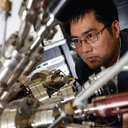Synthesis of radioiodinated 1-deoxy-nojirimycin derivatives: novel glucose analogs.
Palabras clave
Abstracto
Novel lipophilic and neutral glucose analogs, which are potentially useful for tumor imaging, have been developed. They are designed to circumvent Glut-facilitated transport mechanism, and direct the localization by either hexokinase binding or enzyme reactions (phosphorylation) as potential metabolic markers of tumor cells. Syntheses of tetraacetylated N-(3'-iodo-2'-propenyl)-1-deoxy-nojirimycin (11) and N-(3'-iodo-benzyl)-1-deoxy-nojirimycin (14) were achieved by reacting 1-deoxy-nojirimycin with appropriate alkylating agents. The corresponding tri-butyltin derivatives were also prepared as the starting materials for preparation of I-125-labeled compounds for biodistribution study in rats. Biodistribution in rats showed that [123I]14 exhibited a modest initial brain uptake and retention at a later time (0.59, 0.38, 0.30, and 0.30% dose/organ at 2, 30, 60, and 120 min after an intravenous [i.v.] injection, respectively), whereas [125I]11 displayed a lower brain uptake (0.35, 0.27, 0.20, and 0.18% dose/organ at 2, 30, 60, and 120 min). In addition, compounds with free hydroxyl groups (12 and 13) were also obtained. As expected, after an i.v. injection, these free hydroxyl compounds showed a dramatic decrease in brain uptake in rats. It appears that both of the acetylated agents (11 and 14), which display higher lipophilicity (partition coefficient [P.C.] = 57.9 and 1,462, respectively), can penetrate the blood-brain barrier (BBB) by a simple diffusion mechanism whereas the free hydroxy compounds (12 and 13), with lower lipophilicity (P.C. = 0.43 and 6.8), showed no brain uptake. A similar pair of glucose derivatives, fluorodeoxyglucose (FDG) and tetraacetylated FDG (AFDG), displayed a dramatic difference in brain uptake in rats. While the lipophilic AFDG (P.C. = 3.79) may penetrate the intact BBB, due to its relatively low P.C. value, the first pass extraction due to simple diffusion mechanism may be low (brain uptake at 2 min was 0.68% dose/organ). The FDG itself has a very low lipophilicity (P.C. = 0.22) but it can be taken up into the brain by a glucose transporter mediated mechanism to cross the BBB (brain uptake at 2 min was 2.53% dose/organ). Preliminary data of these glucose derivatives suggest that further studies are needed to elucidate the uptake and retention mechanisms and their potential application as tumor imaging agents.


